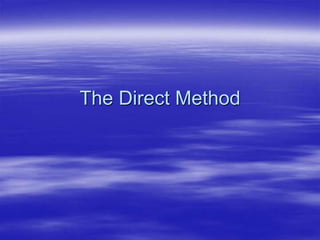The Direct Method.ppt
•Als PPT, PDF herunterladen•
0 gefällt mir•7 views
direct method
Melden
Teilen
Melden
Teilen

Empfohlen
Weitere ähnliche Inhalte
Ähnlich wie The Direct Method.ppt
Ähnlich wie The Direct Method.ppt (20)
Stanford University At California Teaching Methodology

Stanford University At California Teaching Methodology
Applied linguistics Session 5-6_31_10_2021 Approaches & Methods in ELT 2.pdf

Applied linguistics Session 5-6_31_10_2021 Approaches & Methods in ELT 2.pdf
LESSON 1-First and SEcond language acquisition.pptx

LESSON 1-First and SEcond language acquisition.pptx
The Dictionary of Language Learning Vocabulary.docx

The Dictionary of Language Learning Vocabulary.docx
LESSON 1-First and SEcond language acquisition.pptx

LESSON 1-First and SEcond language acquisition.pptx
Session 1 How does my child learn Japanese/Spanish/English in immersion class...

Session 1 How does my child learn Japanese/Spanish/English in immersion class...
Kürzlich hochgeladen
https://app.box.com/s/7hlvjxjalkrik7fb082xx3jk7xd7liz3TỔNG ÔN TẬP THI VÀO LỚP 10 MÔN TIẾNG ANH NĂM HỌC 2023 - 2024 CÓ ĐÁP ÁN (NGỮ Â...

TỔNG ÔN TẬP THI VÀO LỚP 10 MÔN TIẾNG ANH NĂM HỌC 2023 - 2024 CÓ ĐÁP ÁN (NGỮ Â...Nguyen Thanh Tu Collection
Kürzlich hochgeladen (20)
Food Chain and Food Web (Ecosystem) EVS, B. Pharmacy 1st Year, Sem-II

Food Chain and Food Web (Ecosystem) EVS, B. Pharmacy 1st Year, Sem-II
Basic Civil Engineering first year Notes- Chapter 4 Building.pptx

Basic Civil Engineering first year Notes- Chapter 4 Building.pptx
This PowerPoint helps students to consider the concept of infinity.

This PowerPoint helps students to consider the concept of infinity.
Asian American Pacific Islander Month DDSD 2024.pptx

Asian American Pacific Islander Month DDSD 2024.pptx
TỔNG ÔN TẬP THI VÀO LỚP 10 MÔN TIẾNG ANH NĂM HỌC 2023 - 2024 CÓ ĐÁP ÁN (NGỮ Â...

TỔNG ÔN TẬP THI VÀO LỚP 10 MÔN TIẾNG ANH NĂM HỌC 2023 - 2024 CÓ ĐÁP ÁN (NGỮ Â...
Beyond the EU: DORA and NIS 2 Directive's Global Impact

Beyond the EU: DORA and NIS 2 Directive's Global Impact
Measures of Dispersion and Variability: Range, QD, AD and SD

Measures of Dispersion and Variability: Range, QD, AD and SD
Unit-IV; Professional Sales Representative (PSR).pptx

Unit-IV; Professional Sales Representative (PSR).pptx
Ecological Succession. ( ECOSYSTEM, B. Pharmacy, 1st Year, Sem-II, Environmen...

Ecological Succession. ( ECOSYSTEM, B. Pharmacy, 1st Year, Sem-II, Environmen...
Role Of Transgenic Animal In Target Validation-1.pptx

Role Of Transgenic Animal In Target Validation-1.pptx
General Principles of Intellectual Property: Concepts of Intellectual Proper...

General Principles of Intellectual Property: Concepts of Intellectual Proper...
Unit-V; Pricing (Pharma Marketing Management).pptx

Unit-V; Pricing (Pharma Marketing Management).pptx
The Direct Method.ppt
- 2. Background (1) Use the natural way to communicate, like a baby learning its mother tongue. In the late 19th century in Europe, for economic development, the communication among nations became more frequent. Foreign languages learning was highly demanded. Oral communication became the main goal of foreign language teaching.
- 3. Background (2) Revolution to Grammar Translation Method. One of the revolutionists was Francois Gouin. First introduced in France and Germany. Berlitz (Maximilian D. Berlitz,1852-1921) used extensively in Rhode Island, USA, and opened the first language school.
- 4. Language (1) Strong theoretical base in linguistics and psychology. Language is primarily spoken, not written. The basic unit of a language is sentence. Learning how to use a foreign language to communicate. No translation is allowed.
- 5. Language (2) Emphasising vocabulary acquisition through exposure to its use in situations. Meaning is to be conveyed directly in the target language through the use of demonstration and visual aids.
- 6. Teaching (1) Direct communication: as baby learning mother tongue. Imitation: repetition and practice Association: e.g.: hand – arm, shoulder, foot, leg…
- 7. Teaching (2) Kelly’s 5 steps of teaching: Preparation: review previous lesson. Presentation: introduce new lesson. Association: associate previous and new lessons. Systematization: systematize the new lesson in certain situation. Application: practice
- 8. Goal Learn how to communicate I the target language- learn to think in the target language. Correct pronunciation Emphasise on listening and speaking. (GTM: reading, writing and translation) Think in target languages. No native language. No translation. Learning basic sentences, introducing daily life.
- 9. Role of the teacher/ students Teacher centered. Student role is less passive than in GTM. T/S are partners. Teacher is the only demonstrator. He/she never translates but demonstrates the meaning through the use of realia, pictures or pantomime.
- 10. Activities–Berlitz School(1) Never translate: demonstrate. Never explain: act. Never make a speech: ask questions. Never imitate mistake: correct. Never speak with single words: use sentences. Never speak too much: make Ss speak much.
- 11. Activities –Berlitz School(2) Never jump around: follow your plan. Never go too fast: keep the pace of the Ss. Never speak too slowly: speak normally. Never speak too quickly: speak naturally. Never speak too loudly: speak naturally. Never be impatient: take it easy.
- 12. Techniques Reading loud Question and answer exercise Getting students to self-correct Conversation practice Fill-in-the-blank exercise Dictation Map drawing Paragraph writing
- 13. Characteristics (1) Associate meaning and the target language directly. Demonstrate meanings through the use of realia, pictures, and pantomime. Ss speak in the target language a great deal and communicate as if they were in real situations. Method is based upon situations.
- 14. Characteristics (2) Grammar is taught inductively: Ss are presented with examples. Grammar rules are never given. Ss practice vocabulary by using new words in complete sentences.
- 15. Conclusion/ Comments Language learning should be of use. Immersion. Good for the class of small size. Culture should be taught about people’s daily lives.